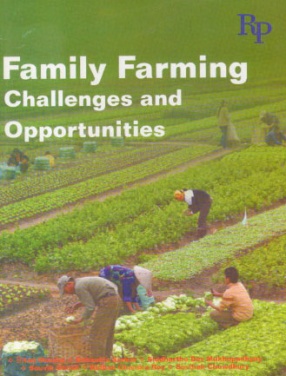Family Farming: Challenges and Opportunities
The problems accumulated due to more than a century of factory farming are aggravated by significant simultaneous and inter-related global phenomena. These include persistent global financial crises, volatility of food prices, widespread social unrest, and growing certainty that the impacts of climate change (such as water shortages, soil degradation, loss of biodiversity, desertification, and depletion of ecosystems) are coming sooner than previously expected. These events have created a renewed impetus and political interest in family farming, with its potential to mitigate such phenomena. The greatest potential for family farming lies in providing healthy and nutritious food for entire populations, including the most vulnerable social groups. It does more than contribute to food production, stimulate local economies, and play a role in the social dynamic. It also ensures health and nutrition aspects of the farming with diversified livelihood options. Family farming systems represent up to 80 percent of the economic production units and more than 60 percent of total natural food production in some countries including India.
Contents: I. Family farming in the context of conservation agriculture: 1. Harnessing the potential of family farming: towards a new paradigm. 2. Family farming with sustainability and ethical paradigm: challenges and opportunities. 3. Empowering women to improve food security: a case study of kitchen garden programme of Karuna Shechen. 4. Dynamics and challenges of food security in India: a macro analysis. 5. Sustainability and food security in family farming: challenges of new epoch. 6. Conservation of land races and wild relatives of crops for sustainable family farming and food security. 7. Homestead farming system for food, nutritional and livelihood security of the households. 8. Sustainable and economical benefits of SRI for enhancement of livelihood of farmers in West Tripura district of Tripura. 9. Integrated farming systems and livelihood security. 10. Conservation agriculture : an approach to achieve livelihood security of small and marginal farmers in West Bengal. 11. Sustainable and resilient family farming practices in groundnut cultivation. II. Crop, livestock, fisheries and natural resources for sustainable food production: 12. Sustainable farming with biofertilizer in rice mungbean cropping sequence. 13. Importance of soil testing in family farming. 14. Improved method of elephant’s foot yam cultivation: a successful initiative taken up by the Rathindra KVK, Birbhum for economic stabilization of the farmers. 15. Potential of commercial vegetable hybrid seed production by farmers. 16. Effect of intercropping on yield and nutrient uptake of garlic (Allium sativum L.) in the foothills of eastern Himalayan region…. III. Challenges, opportunities, strategies and policies for family farming: 37. Strategies for managing risks for family farmers in India. 38. A study on family farming in India: prospects and challenges. 39. Family farming in Bihar: challenges and opportunities. 40. MBAR model: an agribusiness opportunity for rural and urban youths. 41. Variability in family farming: the cases of three states. 42. Sustainability issues in community based watershed management programmes. 43. Progress and performance of agricultural insurance in India. 44. Crop insurance in India: A historical transverse and issues related to extension efforts for resource poor farmers. 45. The question of farm household food security: production and livelihood approach. 46. Programmes and policies to increase oilseeds production in India. 47. Non-availability of crop insurance: a major constraint faced by onion farmers in Akola district of Maharashtra…. IV. Transfer of technology, women empowerment and livelihood improvement in family farm: 48. Application of computer technology in agriculture for livelihood security. 49. Mapping of dairy knowledge information system. 50. Farming performance in women-led agriculture: a comparative look. 51. Influence of SHGs on empowerment of rural women in Chhattisgarh. 52. Livelihood diversification: insights from West Bengal. 53. Livelihood diversity in family farming: an exploration from the sub-Himalayan Districts of West Bengal, India. 54. Missing links between living scenario and growth of irrigation and agriculture sector in Eastern India. 55. Effect of rural leadership training on productivity in three Districts of Bihar State, India. 56. Stress, Chaos, entropy in farmers psyche and their relationship with sustainable agriculture in Indian farming: the pedagogy of both silence and utterance. 57. Perceived impact of energy consumption on social ecology of two districts. 58. Socio-psychological correlates of level of awareness about land and water management practices: a study in Burdwan District of West Bengal. 59. Constrains regarding indigenous method of chilli growing practices-a study in Sikkim. 60. Envisaging the psychological empowerment of the women self help group member in West Bengal. 61. Factors discriminating the empowerment of women through self help groups in Meghalaya. 62. Level of entrepreneurial behavior and perception of constraints among women vegetable growers. 63. A study on extent of use of ICT portals by the development officials in disseminating various agricultural information. 64. Participation of farm women in agro-sectors: a case study in Nalanda District of Bihar. V. Financial and market support for food security in family farming: 65. Impact of MNREGA on food security and rural poverty: envisaged role of PRIS: an empirical analysis of Bihar. 66. Evaluating micro finance institutional framework for agriculture growth and livelihood diversification: conceptual and analytical framework. 67. Alternative measures for food security of poor household in Uttar Pradesh. Index.
Get it now and save 10%
BECOME A MEMBER







Bibliographic information